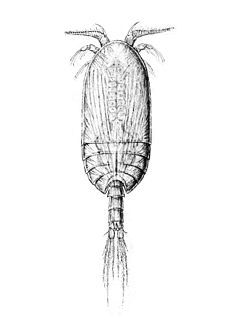Related Research Articles

The Cyclopoida are an order of small crustaceans from the subclass Copepoda. Like many other copepods, members of Cyclopoida are small, planktonic animals living both in the sea and in freshwater habitats. They are capable of rapid movement. Their larval development is metamorphic, and the embryos are carried in paired or single sacs attached to first abdominal somite.
Aglaodiaptomus is a genus of copepods in the family Diaptomidae. They are often bright red or blue due to carotenoid pigments.
Erebonectes is a genus of crustacean in family Epacteriscidae, containing two troglobitic species. E. nasioticus was discovered in Bermuda and described in 1985; it is listed as critically endangered on the IUCN Red List. E. macrochaetus was found on Middle Caicos and described in 1994.
Metacyclops is a genus of copepod crustaceans in the family Cyclopidae, containing 61 species, of which three are listed on the IUCN Red List – M. campestris from Brazil, M. gasparoi from Italy (vulnerable) and M. postojnae from Slovenia (vulnerable).
Notodiaptomus is a genus of copepods in the family Diaptomidae. It is the most widely distributed, most abundant and most species-rich genus of freshwater calanoid copepods in the Neotropics. The genus was erected in 1936 by Friedrich Kiefer for eleven species formerly placed in a wider Diaptomus. Notodiaptomus deitersi was chosen to be the type species by Raúl Adolfo Ringuelet in 1958.
Paracyclopia is a genus of copepods in family Pseudocyclopiidae, containing only the species P. naessi. It is endemic to Bermudan karsts and is critically endangered.
Speleoithona bermudensis is a species of crustacean in the family Speleoithonidae. It is endemic to Bermuda. Its natural habitat is karsts.
Speleophria bivexilla is a species of copepod in the family Speleophriidae. It is endemic to Bermuda.
Speleophria is a genus of marine copepods in the family Speleophriidae. It contains the following species:

The Cyclopidae are a family of copepods containing more than half of the 1,200 species in the order Cyclopoida in over 70 genera.

Canthocamptidae is a family of copepods. Most of the 700 species are confined to fresh water, although there are also marine species. It contains the following genera:
Thomas Elliot Bowman III was an American carcinologist best known for his studies of isopods and copepods.

Gelyella is a genus of freshwater copepods which are "surrounded by mystery". They live in groundwater in karstic areas of southern France and western Switzerland. The two species are the only members of the family Gelyellidae and, although previously placed in the order Harpacticoida, a new order, Gelyelloida, was erected for this family alone.

Clausidium is a genus of copepods that have been found in subtopical to temperate coastal areas along the Pacific, Atlantic and Gulf coasts of North America, the Pacific and Atlantic Coasts of South America, the Atlantic and Mediterranean coasts of Europe, the Atlantic coast of Africa, and the coast of India.
Cletocamptus is a genus of marine and brackish-water copepods, containing the following species:
Halicyclops is a genus of copepods belonging to the family Cyclopidae. There are currently 94 described species found in brackish habitats throughout the world:

Platycopiidae is a family of copepods. Until the description of Nanocopia in 1988, it contained the single genus Platycopia. It now contains four genera, three of which are monotypic; the exception is Platycopia, with 8 species.
Speleophriidae is a family of copepods, comprising seven genera. All are restricted to anchialine caves, with the exception of Archimisophria, which is found in the hyperbenthos of the depths of the Atlantic Ocean. The seven genera are:
Pseudocyclopiidae is a family of copepods, comprising the following genera:

The clade Multicrustacea constitutes the largest superclass of crustaceans, containing approximately four-fifths of all described crustacean species, including crabs, lobsters, shrimps, woodlice, prawns, krill, barnacles, crayfish, copepods, amphipods and others. The largest branch of multicrustacea is the class Malacostraca.
References
- ↑ Carlos Eduardo F. da Rocha & Thomas M. Iliffe (1991). "Speleoithonidae, a new family of Copepoda (Cyclopoida) from anchialine caves on the Bahama Islands" (PDF). Sarsia . 76: 167–175.
- ↑ T. Chad Walter (2009). Walter TC, Boxshall G (eds.). "Speleoithona Rocha C.E.F. & Iliffe, 1991". World of Copepods database. World Register of Marine Species . Retrieved January 10, 2012.